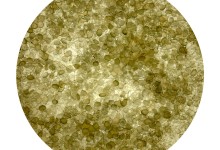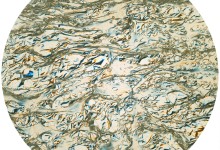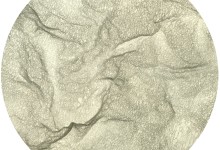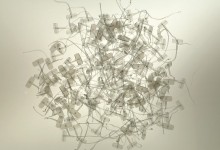Text by Marie-Eve Beaupré
The universe of science has a vast field of experimentation in which the researcher works the researcher works with hypotheses, methods, techniques and protocols. protocols. It shares with that of artistic research several problems and, moreover, a common mandate: discovery. If the macroscopic representations of the starry sky seem today to be part of the familiar images, it seems unlikely that a few pieces of plastic – a material so a few pieces of plastic – such a banal material! – could arouse wonder. And yet… The artist knows how to make our perception of matter perception of the matter; sometimes it is only a question of modifying the scale of dimensions between the real and its representation.
Laurent Lamarche’s research aims at creation, between specimen and narrative, of narrative potentialities at the border of the infinitely big and the infinitely small. Inspired by the processes of scientific imagery and its modes of inventory, he borrows a part of its vocabulary and its devices of presentation to the researcher in microbiology. His object of study, the plastic, is subjected to numerous experiments. In the workshop, the material is heated, glued, stretched, bent, twisted, folded, then organized in a repertory of forms among which among which some resemble living organisms. The artist conceives in these gestures of the fictional objects sculpted, assembled, digitized, photographed, whose representations suggest, in appearance, the possibilities offered by the technology.
If transparency is a plastic quality specific to his sculptures, it is motivated by observations of microscopic life. By studying micro-organisms, one realizes that, in spite of their great diversity, these living beings have in common to be transparent or translucent, in particular the mycoplasm, a small bacterium, without wall, of which there are several species. It is the first artificially reproduced bacterium, i.e. built by genetic engineering around a synthetic chromosome. The bacterium as an artifice, here is a pretext for fiction.
By referring thus to the scientific research, Laurent Lamarche points out in his work an interest for the fictional explorations related to the new forms of life. Where art and genetics intersect, we find the artificial, the manipulated, which links technology to nature. If, in this exhibition, the set of works












